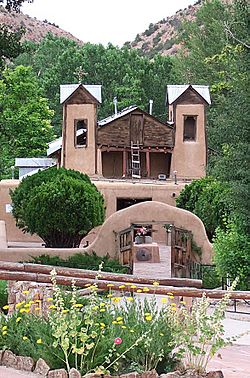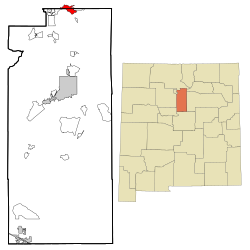Chimayo
| Chimayó, New Mexico | |
|---|---|
| CDP | |

El Santuario
|
|
| Nickname(s): El Potrero Santificado, Chima | |
 Location of Chimayó, New Mexico |
|
| Location in the United States | |
| Coordinates: 36°0′12″N 105°56′25″W / 36.00333°N 105.94028°WCoordinates: 36°0′12″N 105°56′25″W / 36.00333°N 105.94028°W | |
| Country | United States |
| State | New Mexico |
| Counties | Rio Arriba, Santa Fe |
| Government | |
| • County Commission | Barney Trujillo (Rio Arriba) Henry Roybal (Santa Fe) |
| Area | |
| • Total | 5.5 sq mi (14.1 km2) |
| • Land | 5.5 sq mi (14.1 km2) |
| • Water | 0.0 sq mi (0.0 km2) |
| Elevation | 6,073 ft (1,851 m) |
| Population (2010) | |
| • Total | 3,177 |
| • Density | 535.9/sq mi (208/km2) |
| • Demonym | Chimayoan |
| Time zone | Mountain (MST) (UTC-7) |
| • Summer (DST) | MDT (UTC-6) |
| ZIP code | 87522 |
| Area code(s) | 505 |
| FIPS code | 35-14950 |
| GNIS feature ID | 0928711 |
Chimayó is a census-designated place (CDP) in Rio Arriba and Santa Fe counties in the U.S. state of New Mexico; the name derives from a Tewa name for a local landmark, the hill of Tsi Mayoh. The town is unincorporated and includes many neighborhoods, called plazas or placitas, each with its own name, including El Potrero de Chimayó (the plaza near Chimayó's communal pasture) and the Plaza del Cerro (plaza by the hill). The cluster of plazas called Chimayó lies near Santa Cruz about 25 miles north of Santa Fe. The population was 3,177 at the 2010 census.
The Potrero plaza of Chimayó is known internationally for a Catholic chapel, the Santuario de Nuestro Señor de Esquipulas, commonly known as El Santuario de Chimayó. A private individual built it by 1816 so that local people could worship Jesus as depicted at Esquipulas; preservationists bought it and handed it over to the Archdiocese of Santa Fe in 1929. The chapel is now managed by the Archdiocese as a Catholic church. For its reputation as a healing site (believers claim that dirt from a back room of the church can heal physical and spiritual ills), it has become known as the "Lourdes of America," and attracts close to 300,000 visitors a year, including up to 30,000 during Holy Week (the week prior to Easter). It has been called "no doubt the most important Catholic pilgrimage center in the United States." The sanctuary was designated a National Historic Landmark in 1970.
...
Wikipedia

